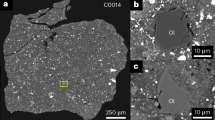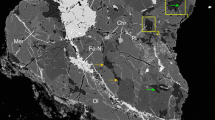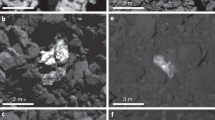Abstract
Particle ejection and redeposition events on the surface of asteroid 101955 Bennu, which led to transport, mixing and loss of material, have been observed frequently by NASA’s OSIRIS-REx mission. Besides large-scale impacts, this may be one of the most important post-accretional processes on small carbonaceous asteroids. Here we looked for relics of such activity in a Bennu analogue, the carbonaceous chondrite Aguas Zarcas. We discovered compact fragments that were strongly shocked, redistributed and deposited onto an unshocked lithology, consistent with surficial re-accretion on Aguas Zarcas’s parent body. Such re-accretion could be driven by large-scale impacts or by frequent pebble transport from endogenous asteroidal activity such as observed at Bennu. The latter hypothesis is supported by the matching size distribution of the Aguas Zarcas compact fragments with that of the Bennu ejecta. Such mixing has hitherto been unexplored in other regolith breccias, and further analysis will determine how common such processes are.
This is a preview of subscription content, access via your institution
Access options
Access Nature and 54 other Nature Portfolio journals
Get Nature+, our best-value online-access subscription
$29.99 / 30 days
cancel any time
Subscribe to this journal
Receive 12 digital issues and online access to articles
$119.00 per year
only $9.92 per issue
Buy this article
- Purchase on Springer Link
- Instant access to full article PDF
Prices may be subject to local taxes which are calculated during checkout





Similar content being viewed by others
Data availability
All data needed to evaluate the conclusions in the paper are present in the paper and the Supplementary Information. The original μCT data are deposited in MorphoSource, a data repository specialized for 3D representations of physical objects. The DOIs for the μCT data from the University of Chicago’s PaleoCT Lab are as follows: RF-1 (10.17602/M2/M450464), RF-2 (10.17602/M2/M450467), RF-3 (10.17602/M2/M450470), CF-1 (10.17602/M2/M450431), CF-2 (10.17602/M2/M450434), CF-3 (10.17602/M2/M450437), CF-4 (10.17602/M2/M450440), CF-5 (10.17602/M2/M450443), CF-6 (10.17602/M2/M450446), CF-7 (10.17602/M2/M450449), CF-8 (10.17602/M2/M450452), CF-9 (10.17602/M2/M450455), CF-10 (10.17602/M2/M450458), and CF-11 (10.17602/M2/M450461). The DOIs for the μCT Data from the University of Texas High-Resolution X-ray Computed Tomography Facility (UTCT) are as follows: Leoville (10.17602/M2/M446809), Murchison (10.17602/M2/M446787), RF-1 (10.17602/M2/M446768), and CF-10 (10.17602/M2/M446740). Source data are provided with this paper.
Code availability
Monte Carlo simulations with MATLAB code are deposited in Knowledge@UChicago47, a repository hosted by the University of Chicago.
References
Lauretta, D. S. et al. Episodes of particle ejection from the surface of the active asteroid (101955) Bennu. Science 366, eaay544 (2019).
Chesley, S. R. et al. Trajectory estimation for particles observed in the vicinity of (101955) Bennu. J. Geophys. Res. Planets 125, e2019JE006363 (2020).
Rubin, A. E. Collisional facilitation of aqueous alteration of CM and CV carbonaceous chondrites. Geochim. Cosmochim. Acta 90, 181–194 (2012).
Bischoff, A., Scott, E. R. D., Metzler, K. & Goodrich, C. A. in Meteorites and the Early Solar System II (eds Lauretta, D. S. & McSween, H. Y., Jr.) 679–712 (Univ. of Arizona Press, Tucson, AZ, 2006).
Bischoff, A., Schleiting, M., Wieler, R. & Patzek, M. Brecciation among 2280 ordinary chondrites—constraints on the evolution of their parent bodies. Geochim. Cosmochim. Acta 238, 516–541 (2018).
Hamilton, V. E. et al. Evidence for widespread hydrated minerals on asteroid (101955) Bennu. Nat. Astron. 3, 332–340 (2019).
Kerraouch, I. et al. The polymict carbonaceous breccia Aguas Zarcas: a potential analog to samples being returned by the OSIRIS-REx and Hayabusa 2 missions. Meteorit. Planet. Sci. 56, 277–310 (2021).
Garvie, L. A. Mineralogy of the 2019 Aguas Zarcas (CM2) carbonaceous chondrite meteorite fall. Am. Mineral. 106, 1900–1916 (2021).
Nakamura, T., Tomeoka, K. & Takeda, H. Shock effects of the Leoville CV carbonaceous chondrite: a transmission electron microscope study. Earth Planet. Sci. Lett. 114, 159–170 (1992).
Tomeoka, K., Yamahana, Y. & Sekine, T. Experimental shock metamorphism of the Murchison CM carbonaceous chondrite. Geochim. Cosmochim. Acta 63, 3683–3703 (1999).
Cain, P. M., McSween, H. Y. Jr. & Woodward, N. B. Structural deformation of the Leoville chondrite. Earth Planet. Sci. Lett. 77, 165–175 (1986).
Hanna, R. D., Ketcham, R. A., Zolensky, M. & Behr, W. M. Impact-induced brittle deformation, porosity loss, and aqueous alteration in the Murchison CM chondrite. Geochim. Cosmochim. Acta 171, 256–282 (2015).
Sneed, E. D. & Folk, R. L. Pebbles in the lower Colorado River, Texas a study in particle morphogenesis. J. Geol. 66, 114–150 (1958).
Graham, D. J. & Midgley, N. G. Graphical representation of particle shape using triangular diagrams: an excel spreadsheet method. Earth Surf. Proc. Landf. 25, 1473–1477 (2000).
Woodcock, N. & Naylor, M. A. Randomness testing in three-dimensional orientation data. J. Struct. Geol. 5, 539–548 (1983).
Lindgren, P., Hanna, R. D., Dobson, K. J., Tomkinson, T. & Lee, M. R. The paradox between low shock-stage and evidence for compaction in CM carbonaceous chondrites explained by multiple low-intensity impacts. Geochim. Cosmochim. Acta 148, 159–178 (2015).
Friedrich, J. M. et al. Relationships among physical properties as indicators of high temperature deformation or post-shock thermal annealing in ordinary chondrites. Geochim. Cosmochim. Acta 203, 157–174 (2017).
Scott, E. R. D., Keil, K. & Stöffler, D. Shock metamorphism of carbonaceous chondrites. Geochim. Cosmochim. Acta 56, 4281–4293 (1992).
Rubin, A. E. & Swindle, T. D. Flattened chondrules in the LAP 04581 LL5 chondrite: evidence for an oblique impact into LL3 material and subsequent collisional heating. Meteorit. Planet. Sci. 46, 587–600 (2011).
Nakamura, T., Tomeoka, K., Takaoka, N., Sekine, T. & Takeda, H. Impact-induced textural changes of CV carbonaceous chondrites: experimental reproduction. Icarus 146, 289–300 (2000).
Stöffler, D., Keil, K. & Scott, E. R. D. Shock metamorphism of ordinary chondrites. Geochim. Cosmochim. Acta 55, 3845–3867 (1991).
Rubin, A. E., Trigo-Rodríguez, J. M., Huber, H. & Wasson, J. T. Progressive aqueous alteration of CM carbonaceous chondrites. Geochim. Cosmochim. Acta 71, 2361–2382 (2007).
Sharp, T. G. & DeCarli, P. S. in Meteorites and the Early Solar System II, (eds Lauretta, D. S. & McSween, H. Y., Jr.) 653–677 (Univ. of Arizona Press, Tucson, AZ, 2006).
Ruzicka, A. M. & Hugo, R. C. Electron backscatter diffraction (EBSD) study of seven heavily metamorphosed chondrites: deformation systematics and variations in pre-shock temperature and post-shock annealing. Geochim. Cosmochim. Acta 234, 115–147 (2018).
Ruzicka, A. M. & Hugo, R. C. Probing the thermal and deformation histories of chondrules in a cluster chondrite lithology of Northwest Africa 5205 with electron backscatter diffraction (EBSD) techniques. Meteorit. & Planet. Sci. 56, S1, Abstract 6109, (2021). https://doi.org/10.1111/maps.13727
Kojima, T., Yatagai, T. & Tomeoka, K. A dark inclusion in the Manych LL (3.1) ordinary chondrite: a product of strong shock metamorphism. Antarct. Meteor. Res. 13, 39–54 (2000).
Kring, D. A. et al. Portales Valley: a meteoritic sample of the brecciated and metal-veined floor of an impact crater on an H-chondrite asteroid. Meteorit. Planet. Sci. 34, 663–669 (1999).
Friedrich, J. M., Weisberg, M. K. & Rivers, M. L. Multiple impact events recorded in the NWA 7298 H chondrite breccia and the dynamical evolution of an ordinary chondrite asteroid. Earth Planet. Sci. Lett. 394, 13–19 (2014).
Ohnishi, I. & Tomeoka, K. Dark inclusions in the Mokoia CV3 chondrite: evidence for aqueous alteration and subsequent thermal and shock metamorphism. Meteorit. Planet. Sci. 37, 1843–1856 (2002).
Stöffler, D. & Grieve, R. A. F. in Metamorphic Rocks: A Classification and Glossary of Terms (eds Fettes, D. & Desmons, J.) 82–92 (Cambridge Univ. Press, 2007).
Okada, T. et al. Highly porous nature of a primitive asteroid revealed by thermal imaging. Nature 579, 518–522 (2020).
Hergenrother, C. W. et al. Photometry of particles ejected from active asteroid (101955) Bennu. J. Geophys. Res. Planets 125, e2020JE006381 (2020).
Bottke, W. F. et al. Meteoroid impacts as a source of Bennu’s particle ejection events. J. Geophys. Res. Planets 125, e2019JE006282 (2020).
Molaro, J. L. et al. Thermal fatigue as a driving mechanism for activity on asteroid Bennu. J. Geophys. Res. Planets 125, e2019JE006325 (2020).
Fedorov, A. et al. 3D Slicer as an image computing platform for the Quantitative Imaging Network. Magn. Reson. Imaging 30, 1323–1341 (2012).
Ketcham, R. A. Three-dimensional grain fabric measurements using high-resolution X-ray computed tomography. J. Struct. Geol. 27, 1217–1228 (2005).
Ketcham, R. A. Computational methods for quantitative analysis of three-dimensional features in geological specimens. Geosphere 1, 32–41 (2005).
Turner, F. J. & Weiss, L. E. Structural Analysis of Metamorphic Tectonites (McGraw–Hill, 1963).
Britt, D. T. & Consolmagno, G. Stony meteorite porosities and densities: a review of the data through 2001. Meteorit. Planet. Sci. 38, 1161–1180 (2003).
Consolmagno, G. J., Britt, D. T. & Macke, R. J. The significance of meteorite density and porosity. Geochem 68, 1–29 (2008).
Rai, N. & van Westrenen, W. Lunar core formation: new constraints from metal–silicate partitioning of siderophile elements. Earth Planet. Sci. Lett. 388, 343–352 (2014).
van Kan Parker, M. et al. Neutral buoyancy of titanium-rich melts in the deep lunar interior. Nat. Geosci. 5, 186–189 (2012).
Weber, R. C., Lin, P.-Y., Garnero, E. J., Williams, Q. & Lognonné, P. Seismic detection of the lunar core. Science 331, 309–312 (2011).
Walsh, K. J. Rubble pile asteroids. Annu. Rev. Astron. Astrophys. 56, 593–624 (2018).
Lauretta, D. S. et al. The OSIRIS-REx target asteroid (101955) Bennu: constraints on its physical, geological, and dynamical nature from astronomical observations. Meteorit. Planet. Sci. 50, 834–849 (2015).
Krasinsky, G. Hidden mass in the asteroid belt. Icarus 158, 98–105 (2002).
Yang, X. MATLAB code for a simple model of ejection events on small asteroids. Knowledge@UChicago https://doi.org/10.6082/uchicago.3914 (2022).
Acknowledgements
P.R.H. thanks the Boudreaux family for donating Aguas Zarcas to the Field Museum’s Robert A. Pritzker Center. Funding from NASA’s Emerging Worlds program (80NSSC21K0389 to P.R.H. and 80NSSC21K0374 to A.M.D.) and from National Science Foundation (grant EAR-1762458 to UTCT Facility) is gratefully acknowledged. P.R.H., X.Y. acknowledge support for this project from the Field Museum’s Science Innovation Award and the TAWANI Foundation. We thank J. Holstein and K. Keating for help with sample preparation, J. Maisano for µCT data acquisition of samples acquired at the High-Resolution X-ray Computed Tomography Facility of the University of Texas at Austin (UTCT), G. Olack for maintaining the FIB-SEM facility at the University of Chicago and J. Greer for discussions regarding components of AZ and scientific illustration. X.Y. acknowledges support from UTCT for attending the UTCT Short Course: Quantitative Analysis with XCT.
Author information
Authors and Affiliations
Contributions
X.Y. and P.R.H. conceived the study and wrote the paper with input from all authors. R.D.H provided expertise on the data processing, interpretation and visualization. A.M.D contributed to the investigation and Monte Carlo model. A.I.N. conducted the initial μCT scanning of samples. X.Y. and P.R.H prepared the samples for SEM/EDS analysis and A.M.D helped explain the data.
Corresponding author
Ethics declarations
Competing interests
The authors declare no competing interests.
Peer review
Peer review information
Nature Astronomy thanks the anonymous reviewers for their contribution to the peer review of this work.
Additional information
Publisher’s note Springer Nature remains neutral with regard to jurisdictional claims in published maps and institutional affiliations.
Extended data
Extended Data Fig. 1 3D aspect ratios of fitted ellipsoids of chondrules in AZ fragments versus C parameters.
Two groups, regular AZ and compact AZ, are clearly separated, with RF-3 in the compact group. Error bars are one standard deviation (n = 22–85).
Extended Data Fig. 2 Back-scattered electron (BSE) images of regular AZ (left panel; Kerraouch et al. 7) and compact AZ (right panel; this study).
Extended Data Fig. 3 BSE images of chondrules from the compact fragment CF-10.
a, Chondrule mainly consisting of forsterite (Fo), containing round sulfide grains. b, Radial pyroxene (Py) chondrule. c, Porphyritic olivine–pyroxene chondrule containing sulfide (Sul) grains. d, Porphyritic olivine–pyroxene chondrule containing sulfide veins and phyllosilicate (Phy).
Extended Data Fig. 4 Distributions of absolute locations (upper panel) and of displacement angles (lower panel) for redeposition onto a Bennu-like asteroid.
The modeled body has the same size and bulk density as that of Bennu (490 m in diameter and 1.26 g cm–3 in bulk density).
Extended Data Fig. 5 Schematic portrayal of the history of the formation of the Aguas Zarcas chondrite.
Fractures were generated in chondrules before or during the accretion of the parent body and were filled simultaneously by shock mobilization or later by thermal/aqueous alteration. Then a hypervelocity impact caused chondrule flattening and fracturing in the matrix, and the compact AZ lithology was formed. The compact AZ was fragmented by meteoroid impacts and thermal fracturing. Then particle ejection and reaccretion events redistributed rock fragments with distinct lithologies, mixing compact AZ into regular AZ. Later impacts consolidated the mixed lithologies and resulted in the final ejection.
Supplementary information
Supplementary Information
Supplementary discussion, Figs. 1–4 and Table 1.
Source data
Source Data Fig. 2
Statistical source data.
Source Data Fig. 3
Statistical source data.
Source Data Fig. 4
Statistical source data.
Source Data Fig. 5
Statistical source data.
Source Data Extended Data Fig. 1
Statistical source data.
Source Data Extended Data Fig. 4
Statistical source data.
Rights and permissions
Springer Nature or its licensor holds exclusive rights to this article under a publishing agreement with the author(s) or other rightsholder(s); author self-archiving of the accepted manuscript version of this article is solely governed by the terms of such publishing agreement and applicable law.
About this article
Cite this article
Yang, X., Hanna, R.D., Davis, A.M. et al. A record of post-accretion asteroid surface mixing preserved in the Aguas Zarcas meteorite. Nat Astron 6, 1051–1058 (2022). https://doi.org/10.1038/s41550-022-01746-4
Received:
Accepted:
Published:
Issue Date:
DOI: https://doi.org/10.1038/s41550-022-01746-4
This article is cited by
-
Life on Earth can grow on extraterrestrial organic carbon
Scientific Reports (2024)



